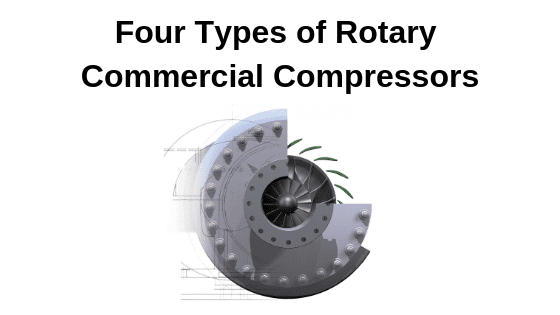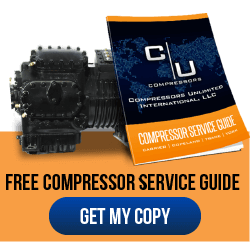The term Rotary Compressors can actually be used to describe several different types of compressor mechanisms. The one thing they have in common is that the air inside is being compressed through the rotating action of some internal component. The way the insides of the compressor look actually breaks down even further. Here are the most common types of commercial rotary compressors in use today:
Screw Type Compressors
Screw type rotary compressors make up a large segment of the compressor market today. Inside the unit, there are two large screws that are rotating against each other. Air comes in through an inlet port at one end of the screws, and then flows between the two rotors. As it moves down the length of the screws, the air gap gets tighter and tighter, compressing the air toward the outlet. These compressors are very popular because they are quiet and they can produce large volumes of air with great consistency. In addition, they come in several varieties, including an oil-free option that reduces the amount of maintenance required to keep the compressor running. Since the two screws do not make contact, there is very little wear other than the motor itself.
Scroll Type Compressors
Scroll type compressors are similar to screw type compressors, except that the internal parts look a little bit different. In this case, there are two spirals or scrolls and one of them remains stationary. Air comes in along the outside edge of the scroll and gets pulled in toward the center of the spiral in tighter and tighter circles before it is forced down through the center outlet. These compressors require little maintenance and they are notably smaller than screw type compressors so they are perfect for limited space applications.
Vane Type Compressors
The third type of rotary compressor is the vane type. This system uses a set of vanes that are slightly offset within the inner chamber. As air comes in through the inlet, rotating vanes push the air along into a tighter and tighter edge of the circle, effectively compressing it while using minimal effort and travel of the air itself. These are very simple compressors that are easy to maintain as well, but vanes wear down over time and can become less effective at forcing the air into the compressed space. In many cases, replacement vanes are available to restore the compressor to its original operating tolerances every few years.
Lobe Type Compressors
Lobe type compressors follow the same model as vane compressors, except that the air comes into a chamber with two spinning wheels. The spinning wheels have small pockets cut into them at opposite ends. As air comes in, it fills that pocket and then gets whisked toward the opposite side of the chamber, forcing it to compress within the shrinking space. This is simply a less wearable version of a vane compressor that is affordable and simple to use. However, lobe type compressors do have some limitations when it comes to capacity, so they may not be the right fit for an application that requires high pressures and constant airflow.
These are the four main types of rotary compressors that you will see today. While vane and lobe type compressors are inexpensive, many industrial operations prefer screw and scroll type compressors because they are able to handle much more air and provide better compression overall. If you are unsure of what kind of scroll compressor you are looking for, we recommend calling Compressors Unlimited today and speaking with a commercial compressor expert about your needs. We can help you find the most efficient commercial compressor possible for your application, environment, and budget.












